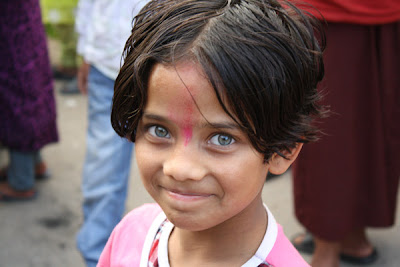
P: My first Thangka!! It is a Sakyamuni Buddha (also known as Siddharta, Gautama, the historical Buddha, the man himself!). In Thangka every representation is highly "codified." The posture of this Buddha is always this, left hand at rest on the lap, sometime with bowl, and right hand touching the ground. The whole body-face-lotus composition is constructed according to sacred geometries.

P: The background is where artist freestyle the most.

P: Prakash Lama (my teacher) instructs me on the preparation of the surface. I find this technique fantastic! It gives a super smooth transportable canvas. One starts with muslin which gets stitched and stretched, then rubbed with something I think is gypsum, hot yak skin glue and water. Then it gets polished between a wood board and a smooth surface (traditionally a stone, now a quart bottle of rum!)



P: Talking with Buddha Moktan, the founder of the Dharmadhatu Foundation, which among other things is a social enterprise that instructs, produces and sells Thangkas. The profits from the sales are used to support indigenous peoples of Nepal and in particular to provide scholarships to Tamang youth from rural areas to study in Kathmandu.

C: I have been so impressed by the patience of the painters (some of which are quite young) often sitting for several hours at a time. The concentration and skill level are so high and the work is amazingly intricate. The stories of workers/painters vary- some come from generations of painters, many have come to it for economical reasons. Its been fascinating seeing the contrast in quality and learning more about the conditions under which they are made. Beware of the Thangka art school/gallery/showroom/sales space, they often are work factories that favor seller over artist.


P: Work in progress.


P: My first Buddha head sketches!!


 C: These structures/swings are amazingly sturdy and seem to pop up all over the place during Tihar.
C: These structures/swings are amazingly sturdy and seem to pop up all over the place during Tihar. C: A bit of street gambling.
C: A bit of street gambling.

 C: I vowed after taking this picture that I wouldn't eat goat again... the little ones are soooooo cute. Sorry to say that didn't last long. Not only are they cute but they taste sooooo good.
C: I vowed after taking this picture that I wouldn't eat goat again... the little ones are soooooo cute. Sorry to say that didn't last long. Not only are they cute but they taste sooooo good. C: I spy our first water buffalo.
C: I spy our first water buffalo.
















































